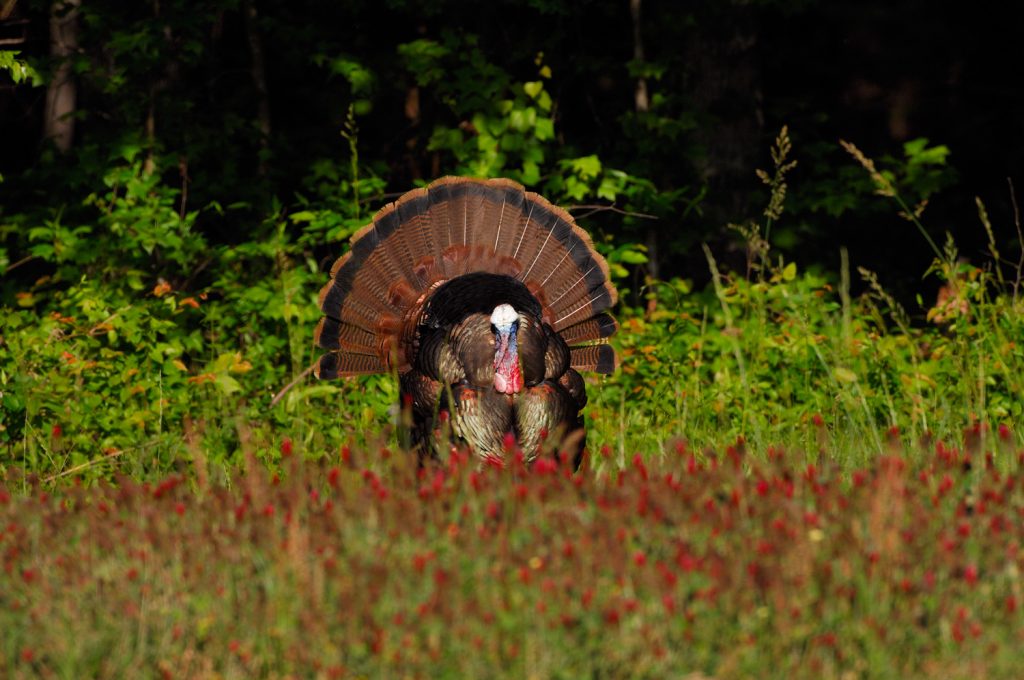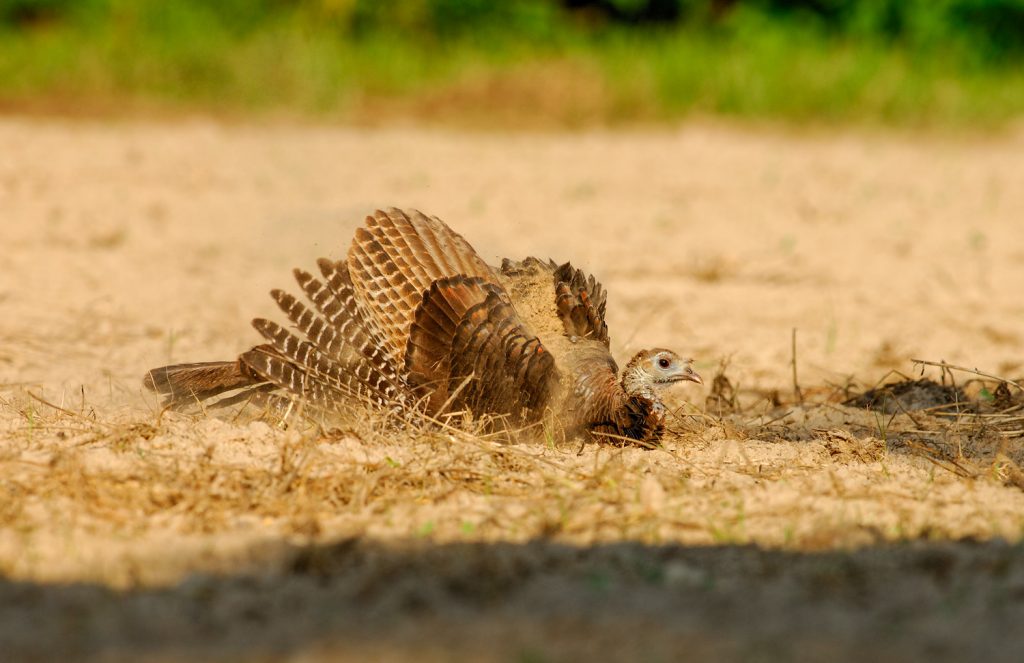Finding Gobblers During the Nesting Period
Tips and observations from the author’s years of photographing turkeys that might help up your success on your next hunt.
Are you a die-hard turkey hunter through the end of the season? Late-season hunting can be tough, especially in pressured areas with long seasons. Most hens are settled into full-time nesting duties. Fewer and warier gobblers wander about searching for hens. They’ve likely heard fake hen hook-up promises galore and encountered decoys, not to mention hunters. The so-called “easy” gobblers were tagged long ago during the breeding and egg-laying periods.
But there’s good news. Gobbling tends to pick up again during the nesting period, as abandoned gobblers search for hens. The start of this phase varies according to geographic regions and weather influences, generally ranging from April in the South to May in the North. Most hens are hunkered down incubating eggs full-time, taking brief breaks to feed, water and dust. Gobblers search for hens or begin to group back with other toms. With the uptick in gobbling, lonely birds announce their locations to persistent, patient hunters with unfilled tags — folks willing to rise early, stay late and go the extra mile.
How do you locate toms in the nesting phase? Here are some tips and observations from the author’s years of photographing turkeys that might help.
Make scouting and field observation a priority
There’s no substitute for an intimate knowledge of your hunting area and local flocks, unless you’re on a fully guided hunt. Start in early spring, and continue throughout, scouting for the usual turkey signs — tracks, droppings, scratching, roosts, drag marks, dust bowls and watering areas. Monitor native and cultivated food-source availability. Note types that attract turkeys in late spring.
Find potential nesting habitat. Hens tend to select areas based on undergrowth characteristics instead of general habitat types. These include limbs, vines, briars, sedge or some other low cover near a log, clearcut, road shoulder, tree base, food plot, utility right-of-way, young pine plantation, forest canopy gap or other opening. The nest site will provide adequate concealment and good visibility for the hen when she scans for danger. Hens prefer nesting sites with nearby herbaceous vegetation, such as clover plots, open fields and edges that harbor insects for early-developing poults.
As hunting season progresses, pay keen attention to hen behavior. Note the direction in which hens leave the flock during the egg-laying period. Determine if there’s suitable nesting habitat in those directions. This is important information. Gobblers cruise those areas when hens are on the nest.
Scouting is critical, but field observation skills will expand your turkey knowledge base and help develop strategies. Observation is a concentrated effort of time afield and patience to learn as much as possible about turkeys and their behavior. In investigative reporting terms, it’s finding answers to the who, what, when, where and why of spring turkeys. Learn behaviors that signal an action. Use observations as a guide, not necessarily gospel, when strategizing.
Must be present to win

This pearl of wisdom is a favorite reminder from the author’s turkey hunting husband, Ron Jolly. He’s participated in, and won, countless turkey wars. By the late season, after weeks of sleep deprivation and long days afield enduring the midseason gobbling lull, it’s tempting to catch a few more winks, skip the pre-dawn listening ritual and bank on raising a bird on the ground. This is no time to slack up, according to Jolly. If turkeys are gobbling, that’s reason enough not to sleep in.
Jolly’s strategy is simple. Be in the turkey woods at sundown at every opportunity. Try to roost a bird or have an idea where birds are late in the day. Listen for fly-up sounds and evening gobbles. Roosted might not be roasted, but it makes wee-hour wake-ups more tolerable.
The same applies to mornings. Grab a caffeinated drink, and head to a listening spot before dawn breaks. A late-season gobbler might sound off repeatedly on the roost, and then hit the ground, stop gobbling and move away quickly. Set up as close as possible. Listen carefully for soft hen tree-calling before flydown, too. Not every hen will be nesting full time. Some will lose their nests to predation, weather conditions, human disturbance or another event. If you’re using decoys, use a hen, and make soft calls. If your initial setup fails, move to get ahead of the bird. Be patient. Late-season birds can be wary and erratic. It might take a morning or two of listening, moving, setting up and observation to close the deal.
Mosey and sneak
This is the slow-motion version of running and gunning for hunting the nesting season, especially if you’re on unfamiliar ground. A gobbler might be almost anywhere as it covers territory, searching for hens. It’s easy to bump birds. Move through areas slowly and cautiously. Imitate leaf scratching while walking. Use locator and hen calls at each stop. Spend ample time listening and glassing.
Gobbling might taper off as birds begin grouping back together. Be ready. New birds might arrive in the area. Listen for the three-note “yawk, yawk, yawk” gobbler yelp. Set up quickly before answering with the same call.
As hens nest, gobblers have more time to feed. Stop near water sources, food plots, open areas and other food sources to call, glass or set up. If decoying, use a hen. Scratch leaves, and offer soft yelps, clucks and purrs. Birds might not be as aggressive in answering or coming to calls after weeks of dominance battles, displaying and breeding.
Extreme weather conditions can take a toll on nesting. Practice safety first, but take advantage of wet-weather days that push turkeys into open areas and onto woods roads. Watch for hens or their sign. Gobblers will usually find them quickly.
Stake out feeding locations near nesting areas
Late-season gobblers typically cover a lot of ground. By midafternoon, some will move to feeding areas near nesting cover and “pitch camp” to wait for hens on break to arrive. I’ve observed gobblers choose a shady spot inside the edge of a field, food plot or opening. Some hung out quietly. Others strutted and gobbled occasionally. Several lone birds rested during warm weather, squatted in shady short cover. Each periodically raised its head like a periscope to survey the area. When a hen arrived, they were rewarded with an opportunity to strut.
Quality optics are essential when glassing field edges during midday. Spend extra time glassing for a bird hidden in the shadows. Make calls while glassing. A squatted bird might suddenly raise its head or stand to check out the sound.
Scout for dust bowl

Turkeys take frequent dust baths as part of feather maintenance and to remove parasites and dead skin. In breaks from long hours on the nest, hens seem to relish a dust bath, flapping large amounts of fine dirt upon their bodies. Dusting bowls indicate a good place to set up for a roaming bird, as gobblers will happily strut for dusting hens. I’ve observed gobblers regularly visiting dusting areas adjacent to nesting habitat. Dusting bowls are highly visible. Hens often use abandoned ant mounds. Scout for bowls along nesting-cover edges, especially where other turkey sign is difficult to see.
Final thoughts
Finding gobblers during the nesting phase can take a fair amount of time and scouting, but for passionate, persistent, patient hunters, the effort is worthwhile to close out a season with excellent table fare and cherished memories.
A reminder is in order. Hens face unbelievable odds against successfully hatching and raising a brood. The incubation period is a hen’s most vulnerable time. Mortality rates are at their highest. Identify potential nesting areas. When scouting and hunting, make an effort to observe hens more closely to determine where they are likely nesting. Resolve to avoid disturbing these locations when afield. Skirt the edges. Make any setups a generous distance from known nesting sites.
CONNECT WITH US
National Wild Turkey Federation
770 Augusta Road, Edgefield, SC 29824
(800) 843-6983
National Wild Turkey Federation. All rights reserved.
